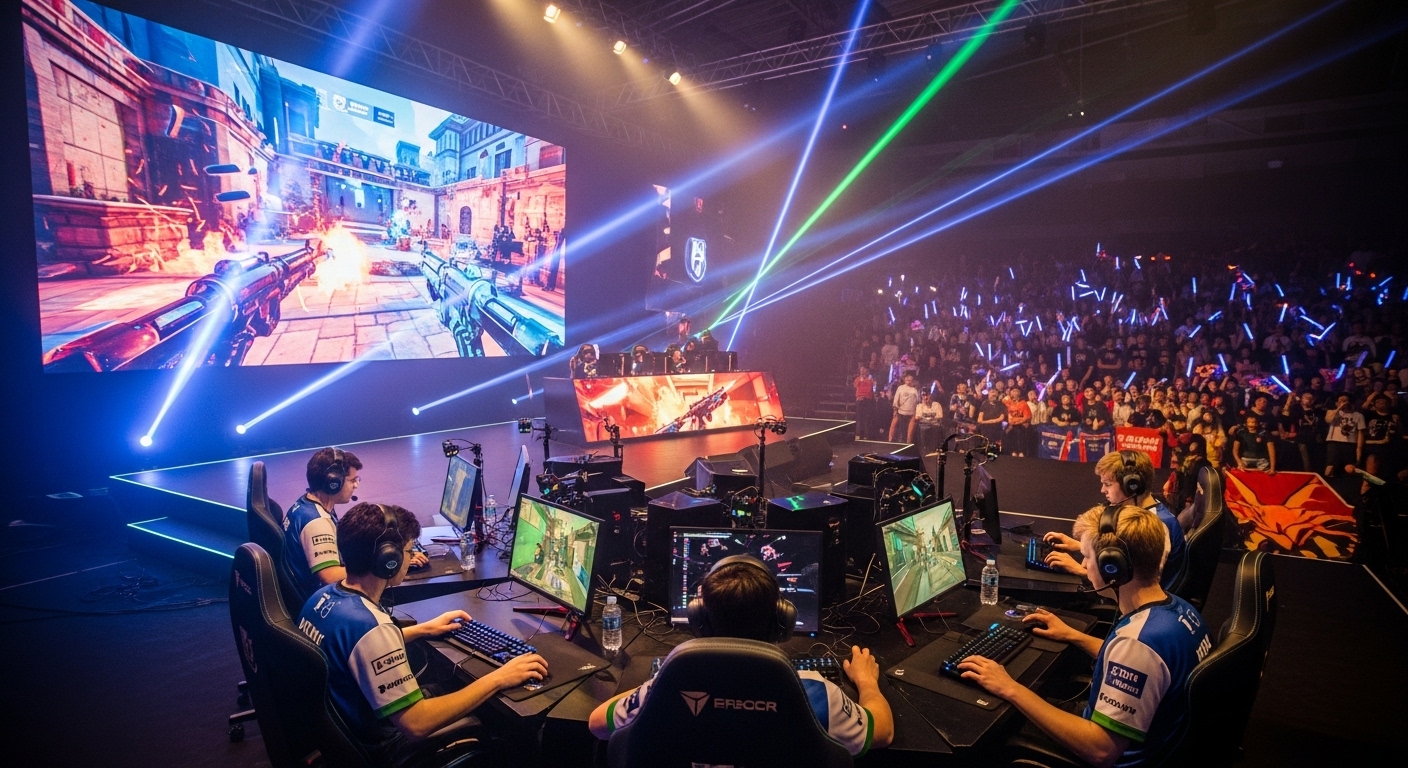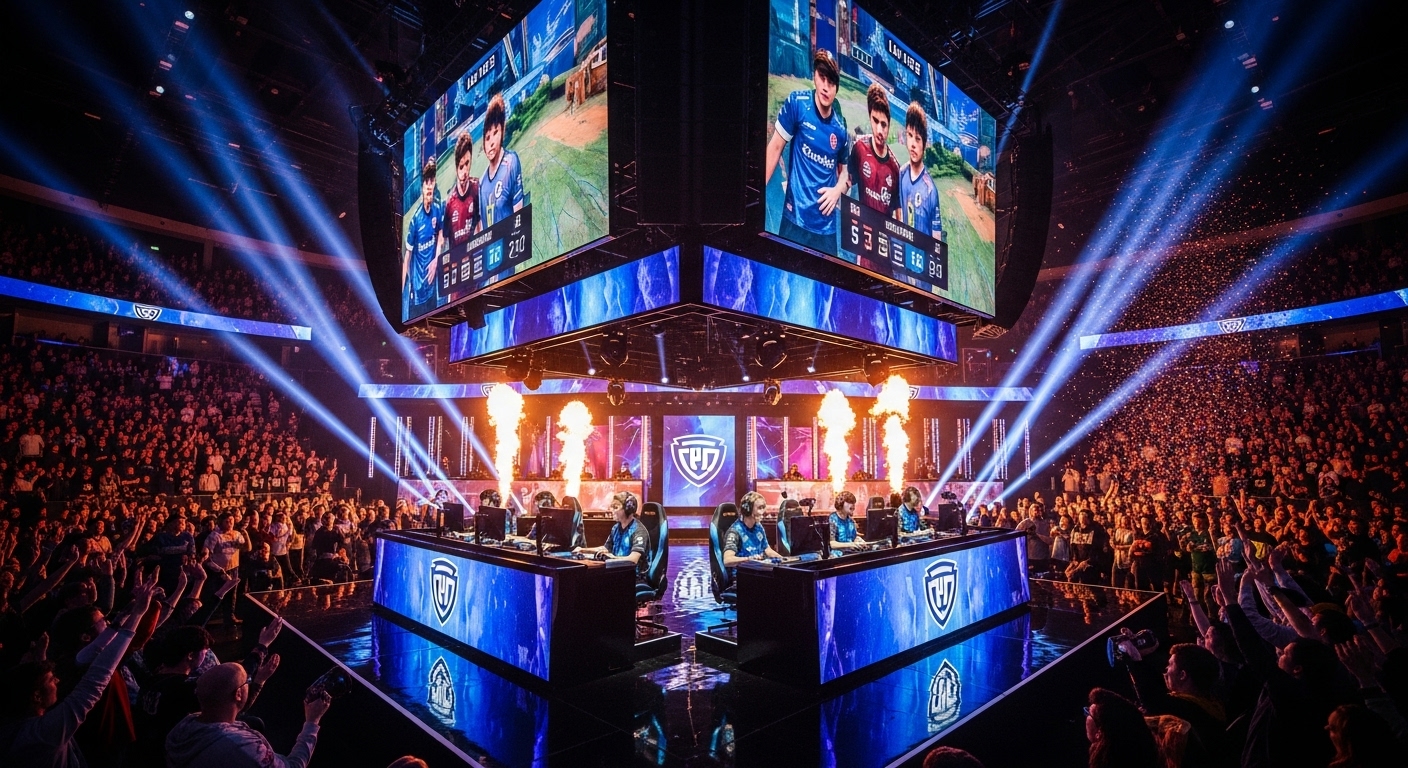Introduction to the World of Esports
Esports, short for electronic sports, has emerged as one of the fastest-growing industries in the world. What once began as small gatherings of video game enthusiasts has transformed into a global phenomenon that rivals traditional sports in both scale and popularity. The concept of competitive gaming is no longer confined to arcades or basements; it now thrives in massive arenas, streamed to millions of viewers worldwide. Esports represents the fusion of technology, competition, entertainment, and culture, creating a new form of digital sport that captures the imagination of players and audiences alike.
The foundation of esports rests on organized, multiplayer video game competitions, often between professional players and teams. Titles such as League of Legends, Counter-Strike, Dota 2, and Fortnite have become iconic pillars in this landscape. These games have not only created new professions but also redefined how people perceive gaming as a legitimate and respectable career path.
Early Beginnings of Competitive Gaming
The roots of esports stretch back to the early days of video gaming in the 1970s and 1980s. The first recognized video game competition took place in 1972 at Stanford University, where students competed in a game called Spacewar. The event was modest, but it set the foundation for what would become a global phenomenon. By the 1980s, arcade games like Pac-Man and Donkey Kong inspired competitive leaderboards where players would fight for the highest scores.
The 1990s marked a significant shift with the rise of the internet and multiplayer connectivity. Games like Quake and StarCraft became popular among early online communities, and organized tournaments began to emerge. The creation of gaming leagues and professional organizations started to take shape, laying the groundwork for the modern esports structure we know today.
The Emergence of Global Esports Titles
As technology improved, so did the complexity and competitiveness of video games. The 2000s saw the rise of esports titles that would define the industry for decades. Counter-Strike became a staple in the first-person shooter genre, attracting massive tournaments and professional teams. Blizzard’s StarCraft dominated the South Korean gaming scene, where players achieved celebrity status. Meanwhile, games like Warcraft III introduced competitive strategy gaming, paving the way for the development of multiplayer online battle arena (MOBA) games like Dota and League of Legends.
League of Legends, launched in 2009, became one of the most influential titles in esports history. Its developer, Riot Games, built an entire ecosystem around professional play, including regional leagues, championships, and dedicated esports infrastructure. This model inspired other developers to integrate competitive gaming directly into their titles, fueling the growth of a sustainable esports ecosystem.
Esports as a Professional Career
The idea of earning a living by playing video games was once dismissed as unrealistic. Today, professional gamers earn substantial incomes through tournament winnings, sponsorships, streaming revenue, and brand partnerships. Teams are now managed like traditional sports franchises, complete with coaches, analysts, nutritionists, and training facilities.
Top esports athletes such as Faker from League of Legends or s1mple from Counter-Strike have achieved global fame and financial success comparable to traditional sports stars. The professionalization of esports has also led to the creation of player contracts, transfer markets, and governing bodies to ensure fair competition and standardization across leagues.
Moreover, universities and colleges have started offering esports scholarships, acknowledging the skill and dedication required to excel in competitive gaming. This shift signifies that esports is no longer just entertainment but a viable career path that requires discipline, teamwork, and strategic thinking.
The Role of Streaming and Media in Esports Growth
One of the main drivers behind the rapid expansion of esports has been the rise of live streaming platforms. Websites like Twitch, YouTube Gaming, and Facebook Gaming have provided a space where players and fans can connect in real-time. The accessibility of live broadcasts has made it possible for anyone with an internet connection to watch world-class competitions from the comfort of their homes.
This new form of media distribution differs from traditional sports broadcasting. Instead of relying on television networks, esports thrives in a digital ecosystem driven by user-generated content, chat interaction, and direct community engagement. Fans are not just passive viewers—they are active participants in shaping the culture around their favorite games and players.
Streaming has also given rise to gaming influencers who bridge the gap between professional players and fans. Streamers like Ninja and Shroud, for example, have achieved celebrity status not only through competition but through their entertaining and charismatic online presence. These personalities have further expanded the audience for esports, attracting mainstream attention and sponsorship opportunities.
Major Esports Events and Tournaments
The scale of modern esports tournaments is staggering. Events like The International for Dota 2 and the League of Legends World Championship attract millions of viewers and offer prize pools exceeding tens of millions of dollars. These tournaments are hosted in massive arenas filled with cheering fans, echoing the energy and atmosphere of traditional sporting events.
The International, organized by Valve Corporation, is a prime example of how esports has redefined competition. Its prize pool is crowdfunded by the gaming community, allowing fans to contribute directly to the tournament’s success. This model showcases the strong bond between players, developers, and fans, creating a sense of shared ownership and celebration.
Other significant events include the Fortnite World Cup, EVO Championship Series for fighting games, and the Call of Duty League. Each of these tournaments brings together the best players from around the world, emphasizing both individual skill and team strategy.
Esports and Mainstream Recognition
In recent years, esports has moved beyond niche communities into mainstream recognition. Major television networks, global sponsors, and traditional sports organizations have started investing in esports. Companies such as Coca-Cola, Intel, and Red Bull sponsor teams and tournaments, while sports clubs like Manchester City and Paris Saint-Germain have established their own esports divisions.
This crossover demonstrates that esports is not just a passing trend but a legitimate entertainment industry with immense economic potential. The inclusion of esports in major multi-sport events, such as the Asian Games, further cements its status as a recognized form of competition. Discussions about including esports in the Olympic Games highlight its growing global influence.
The Economic Power of Esports
The esports industry has become a multibillion-dollar market. Revenue streams include sponsorships, media rights, advertising, ticket sales, and in-game purchases. The digital nature of esports allows for scalable audience engagement and monetization, making it attractive to investors and advertisers.
Game developers have also benefited from the esports ecosystem. A successful competitive title often experiences increased player engagement and game longevity, as fans continue playing and supporting their favorite games long after release. This creates a sustainable cycle of growth where competition drives both community interest and commercial success.
Esports Infrastructure and Team Organizations
Behind every successful esports team lies a complex infrastructure designed to optimize performance. Teams such as Team Liquid, Fnatic, and T1 operate like professional sports organizations. They have dedicated headquarters equipped with high-end gaming setups, training programs, and mental health support for players.
Coaching has become an essential part of esports. Coaches analyze gameplay footage, develop strategies, and guide players through communication and coordination exercises. Analysts use data-driven insights to refine tactics and improve team performance. This professional environment ensures that players maintain consistency and peak mental focus during high-pressure tournaments.
Additionally, esports organizations invest heavily in branding and fan engagement. Merchandise, social media presence, and content creation are key aspects of maintaining a loyal fanbase. These strategies mirror traditional sports marketing, but with the added advantage of direct interaction through digital platforms.
Esports Education and Community Development
Education has started to play a vital role in shaping the future of esports. Many schools and universities now offer courses related to game design, esports management, and digital marketing. Students can learn about the business, technological, and cultural aspects of competitive gaming, preparing them for a wide range of careers beyond playing professionally.
Community development is another essential element. Local tournaments, gaming cafes, and online leagues allow aspiring players to gain experience and exposure. Grassroots initiatives help discover new talent and foster inclusivity, ensuring that esports remains accessible to all.
Women in Esports
The presence of women in esports is steadily increasing, challenging stereotypes and breaking barriers in a male-dominated industry. Female players, streamers, and commentators are gaining recognition for their skills and contributions. Organizations dedicated to supporting women in gaming have emerged, promoting diversity and equality in the esports community.
Representation matters, and as more women take part in esports, the culture around gaming continues to evolve toward inclusivity. Encouraging female participation helps build a more balanced and diverse competitive environment, where talent and passion take precedence over gender.
Challenges Facing the Esports Industry
Despite its success, esports faces several challenges. Player burnout is a major concern due to intense training schedules and the pressure to perform at the highest level. Maintaining physical and mental health is crucial, and organizations are working to provide better support systems for athletes.
Another issue is regulation and governance. Unlike traditional sports, esports lacks a single governing body, leading to inconsistent rules and standards across different games and tournaments. Establishing fair practices, anti-doping measures, and integrity systems remains a priority as the industry matures.
Cybersecurity and cheating also pose risks to competitive integrity. Developers continuously work on improving anti-cheat software and monitoring systems to ensure fair play. Additionally, the rise of betting on esports matches introduces the potential for match-fixing scandals, which need to be addressed through transparency and oversight.
The Cultural Impact of Esports
Esports has transcended gaming to become a major cultural movement. It influences fashion, music, art, and social media trends. Gaming celebrities often collaborate with artists and brands, blurring the lines between entertainment industries. Esports events bring together diverse audiences, fostering a sense of community that goes beyond competition.
Moreover, esports provides opportunities for people to connect globally. Players and fans from different countries share a common language through gaming. This international connectivity promotes cultural exchange and understanding, reinforcing the idea that digital spaces can be powerful tools for unity.
The Future of Esports
The future of esports looks brighter than ever. Advancements in virtual reality, artificial intelligence, and cloud gaming will continue to reshape the landscape. As technology evolves, new genres and forms of competition will emerge, expanding the possibilities of what esports can achieve.
Traditional sports organizations will likely deepen their collaboration with esports, creating hybrid events and training models. Governments and educational institutions will continue integrating esports into their programs, fostering innovation and career opportunities.
The integration of virtual reality and augmented reality could redefine the viewer experience, making spectators feel as though they are part of the action. Furthermore, the rise of mobile gaming ensures that esports remains accessible to a wider audience, particularly in regions where traditional gaming hardware is less common.
Conclusion
Esports represents more than just competition; it symbolizes a global cultural shift. What began as small gatherings of passionate gamers has evolved into a worldwide industry that blends entertainment, technology, and community. Esports has challenged traditional notions of sports, redefined careers, and connected people across borders through shared digital experiences.
As the industry continues to expand, its influence will only grow stronger. Esports is not a temporary trend—it is a new era of competition that embodies the spirit of innovation and the boundless potential of human creativity. The digital arena has become a stage where dreams are realized, skills are celebrated, and the future of sport is being rewritten.



